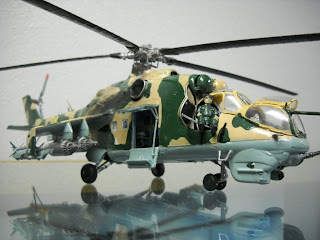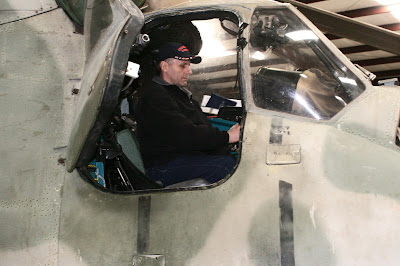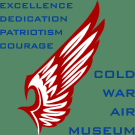Some of the recent work at the Cold War Air Museum has focused on bringing one of the museum's L-29 projects up to flying status.
The group working on Bord 41 pauses in front of the aircraft to smile about how the work is progressing.
The sound of jet engines is a happy sound to the volunteers and to the airport fuel concession.
A total of four L29's were brought out, started, taxied or flown (several at the airport are already licensed and flying) over the weekend.
Following one of these engine and taxi tests, the photographer got the chance to get (almost) everyone in front of Bord 41 for the lead picture above.
Work will continue on the aircraft until it's successful airworthiness inspection, scheduled for the near future.
Sunday, February 27, 2011
Thursday, February 24, 2011
Model Aircraft on Display
The Cold War Air Museum brings together volunteers and associates with diverse interests to create displays and activities of interest to the public. Aircraft models at the museum compliment the full size aircraft displayed and flown by museum associates.
With one display case already full, the museum would welcome the donation of more display cases to extend the collection and add other articles of interest.
Some of the models displayed are of aircraft far to large to be displayed at the current museum location. Adding such models helps museum visitors relate the aircraft at the museum to other aircraft of the cold war era.
Models also help display the many colors and configurations found on aircraft in the field.
Sean, one of our volunteers, especially enjoys creating models for the museum. We appreciate his ongoing efforts in this area of interest at the Cold War Air Museum.
With one display case already full, the museum would welcome the donation of more display cases to extend the collection and add other articles of interest.
Some of the models displayed are of aircraft far to large to be displayed at the current museum location. Adding such models helps museum visitors relate the aircraft at the museum to other aircraft of the cold war era.
Models also help display the many colors and configurations found on aircraft in the field.
Sean, one of our volunteers, especially enjoys creating models for the museum. We appreciate his ongoing efforts in this area of interest at the Cold War Air Museum.
Sunday, February 20, 2011
L29 Delfin Soon to Fly
With so many projects ongoing at the Cold War Air Museum, some inevitably get delayed longer than others. The assembly of this L-29 actually started several years ago, but was put on hold when a fuel leak was discovered. Knowing that the aircraft would have to be disassembled to find the leak, the project was set aside until time and manpower became available.
This weekend, we were fortunate to bring the resources together that were needed. After demating the nose section and removing the front fuel tank, the leak was found.
The leak was not visible through any of the various inspection openings. While it was hoped that it might simply be from a hose, connector or seal that could easily be tightened or replaced, replacement front and rear fuel tanks were readied, just in case.
As it turned out, one of the tanks was indeed the culprit. Water, the natural enemy of aircraft, had accumulated in the bottom of the front tank and over the years, corrosion had taken it's toll.
As always, when an aircraft is opened up, a thorough inspection and cleaning took place.
With no other damage found, the front compartment was made ready to accept the replacement tank.
The new tank is carefully guided into place. The front tank has channels on each side where air ducts feed the engine from the wing roots. The rear tank has a "doughnut hole" in the center where the air passes through to feed the engine intake.
With the tank installed, the nose is remated to the center section. Having the necessary equipment makes the job easier. While the nose was supported and moved on a wheeled nose dolly, the center section was supported by jacks as the tail rested on a tail dolly. Each piece is a standard piece of L29 ground support equipment.
In addition to the numerous cables, controls, pneumatic and hydraulic connections, the nose section is structurally attached to the center section by a ring of (many) bolts reached through the rear cockpit and lower fuselage. Here Mike is shown working up a magic combination of extensions to get to the bolts.
The best man for the job did not have much room to work in. Unfortunately it seems like aircraft designers often expect techs to be impossibly small and limber, with extra long arms and at least six fingers on each hand to wiggle things into places they can't see.
While the aircraft was up on jacks, it was also a good opportunity to replace tires and check the brakes.
Brad makes quick work of the job, this bird is now ready to stop and go. The main tires on the L29 are the same as the main tires on the Mi-2, so one stock of consumables provides for both.
While the old tires showed normal wear for the aircraft, one of the tubes was creased. The new tubes were installed with care (and talcum powder) to ensure that the new tube could expand evenly when it is first inflated.
This picture is not what it looks like. Larry is NOT about to grease Zach's face. Instead, Zach is simply monitoring as Larry applies grease to some of the many fittings found throughout the gear system.
With lots of coffee needed to fuel the workers, the L29's IFF compartment became an impromptu table. With both the fixed wing and helicopter group working on the project to meet a tight schedule, a great deal was accomplished in a short time. This project looks like it is going to be a resounding success, with everyone looking forward to taking a ride in Bord 41 soon.
This weekend, we were fortunate to bring the resources together that were needed. After demating the nose section and removing the front fuel tank, the leak was found.
The leak was not visible through any of the various inspection openings. While it was hoped that it might simply be from a hose, connector or seal that could easily be tightened or replaced, replacement front and rear fuel tanks were readied, just in case.
As it turned out, one of the tanks was indeed the culprit. Water, the natural enemy of aircraft, had accumulated in the bottom of the front tank and over the years, corrosion had taken it's toll.
As always, when an aircraft is opened up, a thorough inspection and cleaning took place.
With no other damage found, the front compartment was made ready to accept the replacement tank.
The new tank is carefully guided into place. The front tank has channels on each side where air ducts feed the engine from the wing roots. The rear tank has a "doughnut hole" in the center where the air passes through to feed the engine intake.
With the tank installed, the nose is remated to the center section. Having the necessary equipment makes the job easier. While the nose was supported and moved on a wheeled nose dolly, the center section was supported by jacks as the tail rested on a tail dolly. Each piece is a standard piece of L29 ground support equipment.
In addition to the numerous cables, controls, pneumatic and hydraulic connections, the nose section is structurally attached to the center section by a ring of (many) bolts reached through the rear cockpit and lower fuselage. Here Mike is shown working up a magic combination of extensions to get to the bolts.
The best man for the job did not have much room to work in. Unfortunately it seems like aircraft designers often expect techs to be impossibly small and limber, with extra long arms and at least six fingers on each hand to wiggle things into places they can't see.
While the aircraft was up on jacks, it was also a good opportunity to replace tires and check the brakes.
Brad makes quick work of the job, this bird is now ready to stop and go. The main tires on the L29 are the same as the main tires on the Mi-2, so one stock of consumables provides for both.
While the old tires showed normal wear for the aircraft, one of the tubes was creased. The new tubes were installed with care (and talcum powder) to ensure that the new tube could expand evenly when it is first inflated.
This picture is not what it looks like. Larry is NOT about to grease Zach's face. Instead, Zach is simply monitoring as Larry applies grease to some of the many fittings found throughout the gear system.
With lots of coffee needed to fuel the workers, the L29's IFF compartment became an impromptu table. With both the fixed wing and helicopter group working on the project to meet a tight schedule, a great deal was accomplished in a short time. This project looks like it is going to be a resounding success, with everyone looking forward to taking a ride in Bord 41 soon.
Saturday, February 12, 2011
MiG Manuals
One of the goals of the Cold War Air Museum is the restoration of Eastern Block aircraft.
We are fortunate that the Soviets distributed their maintenance manuals all over the world along with their equipment. The Soviet designers also helped our cause tremendously by using (in general), proven and robust designs. Many of the parts in each of these aircraft are often found in other aircraft as well.
This is a sample from some of the multiple cases of manuals that various associates have purchased from around the world. Location diagrams like these help generate a mental picture of the inside of the aircraft, where parts are located and how they connect together.
Identifiers on the equipment diagrams help direct technicians to specific sections as necessary.
We are glad that the Soviets relied on "old fashioned" paper products for this material. No computer or microfiche reader necessary and the technical language is straightforward to translate.
We are fortunate that the Soviets distributed their maintenance manuals all over the world along with their equipment. The Soviet designers also helped our cause tremendously by using (in general), proven and robust designs. Many of the parts in each of these aircraft are often found in other aircraft as well.
This is a sample from some of the multiple cases of manuals that various associates have purchased from around the world. Location diagrams like these help generate a mental picture of the inside of the aircraft, where parts are located and how they connect together.
Identifiers on the equipment diagrams help direct technicians to specific sections as necessary.
We are glad that the Soviets relied on "old fashioned" paper products for this material. No computer or microfiche reader necessary and the technical language is straightforward to translate.
Saturday, February 5, 2011
Cosmonaut visits the Cold War Air Museum
Cosmonaut Andrei Borisenko is currently training with NASA in Houston. During his limited free time, we were fortunate that he chose the Cold War Air Museum as one of the places he wanted to visit in Texas. In March, he will be off for a six month stay at the International Space Station.
Mister Borisenko has some L-39 time and was curious to see the exhibits in the museum.
We were happy to have him inspect our ex-Soviet aircraft such as the Mi-24...
As well as our American aircraft such as the AH-1 Cobra...
Mister Borisenko speaks excellent English but was accompanied by a NASA interpreter who we hope enjoyed the visit as well.
Mister Borisenko has some L-39 time and was curious to see the exhibits in the museum.
We were happy to have him inspect our ex-Soviet aircraft such as the Mi-24...
As well as our American aircraft such as the AH-1 Cobra...
Mister Borisenko speaks excellent English but was accompanied by a NASA interpreter who we hope enjoyed the visit as well.
Subscribe to:
Comments (Atom)


































